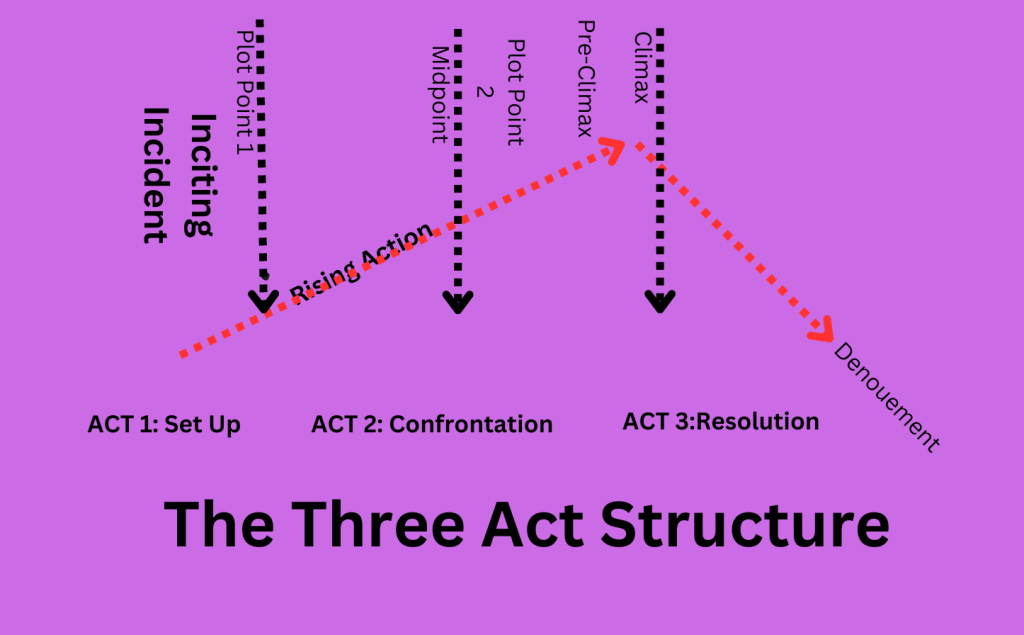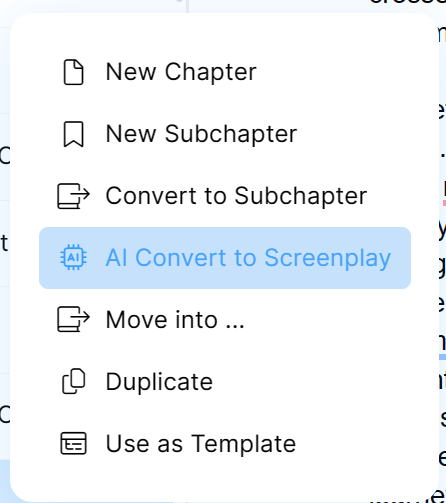How To Turn A Novel Into A Screenplay: 4 Simple Steps

Perhaps you’ve written a novel and thought, “This would be incredible on the big screen!” Or you’re tasked with converting someone else’s novel to a screenplay. Adapting a book into a screenplay can be daunting, but it doesn’t have to be complicated. Today, I’ll cover how to turn a novel to a screenplay using a method inspired by screenwriter Syd Field’s book “Screenplay: The Foundation of Screenwriting.”
Novels and screenplays are very different mediums and there is an art to condensing books down to work as movies. Below, we’ll cover how to imagine your novel as a three-act film and find the pivotal plot points. How to turn your thoughts into action that works on the screen, how to break things down for easy editing, and finally, how to put it all together for a cohesive final product.
Follow these four steps to transform your novel into a captivating screenplay.
Table of Contents
How To Turn A Novel Into A Screenplay: 4 Simple Steps
Step 1: Break Your Novel Into 3 Acts

Novels and screenplays both have a beginning, middle, and end. However, screenplays are much more “bare bones” and concise than books. In a novel, longer passages of description and inner character thought are fine. But they don’t work well for a screenplay. It’s important to think of your screenplay as a blueprint for a filmmaker instead of something meant to be read from front to back for enjoyment.
The first step of converting your book is to map it out like a movie. The simplest way to do this is with the 3-act structure. Each act serves a specific purpose, lays the groundwork for the next, and ensures your pacing is good. You can find a more in-depth explanation here: Screenplay Structure: Tips to Engage Audiences
Go through your novel and identify the events that mark your first, second, and third act.

Here is how you want to break your novel up:
Act 1 (Roughly pages 1-30)
The first act should be around 30 pages of your screenplay. While this is a guideline and doesn’t always have to be exact, I recommend you stick to 30 pages as it’ll help keep things on track and simple. Here is a rundown of what you’ll want to cover in Act 1:
- Introduce Your Characters: This is your chance to establish who your characters are and what drives them. Don’t just tell us they’re a detective; show them tirelessly pursuing a lead through a bustling marketplace.
- Set the Scene: Immerse future viewers in the world. Use sensory details to paint a vivid picture.
- Establish the Central Conflict: Introduce the main problem your protagonist faces. Is it a looming alien invasion, a deadly mystery shrouded in secrecy, or a personal quest for redemption? Hint at the stakes involved – the fate of humanity, a character’s sanity, or a broken family dynamic.
Act 2 (Roughly pages 30-90)
Act 2 is where your story truly takes off. Here’s where your protagonist actively pursues their goal and faces a series of challenges that raise the stakes and propel them towards the climax. Here is an overview of what falls into Act 2.
- Protagonist Takes Charge: Your protagonist transitions from simply reacting to events to actively pursuing their objective.
- Obstacles and Roadblocks: This is where you throw wrenches into your protagonist’s plans. Introduce complications that test their resolve and force them to adapt.
- Rising Tension: As your protagonist overcomes each obstacle, the challenges should become progressively more difficult. This keeps the audience engaged and invested in the outcome.
Act 3 (Roughly pages 90-120)
Act 3 delivers the satisfying payoff to your story’s central conflict.
- Darkest Hour: This is the turning point where all seems lost, such as a betrayal that jeopardizes their entire mission.
- Climax and Resolution: The climax is the heart of Act 3, where your protagonist confronts their antagonist and resolves the central conflict.
- Denouement: (Optional) The denouement is a brief final scene that ties up any loose ends and shows the aftermath of the climax.
Find The Pivotal Moments (Plot Points)
Once you know where your acts start, you need to identify your pivotal moments. Within each act, there are two key turning points called plot points that propel the story forward. If they don’t jump out, worry not. Here is an idea of what plot points could look like and roughly where they should fall within the screenplay:
- Act 1 Plot Point (Around Page 25): This is a major event that forces your protagonist to take decisive action and commit to the challenges of Act 2. For Maya, it could be deciphering a cryptic clue that reveals the urgency of the mission and the dangers ahead.
- Act 2 Plot Point (Around Page 75): The second plot point throws another obstacle or complication at your protagonist, raising the stakes even higher and forcing them to adapt. Perhaps a crewmate betrays them, a critical system malfunctions, or they encounter a new and unforeseen threat.
Step 2: Trim What Is Not Needed

Now it’s time to take your mapped-out novel and tighten it up. Or, more literally, shrink it down. A novel will have a lot that won’t go into the screenplay. For example, long sections of description aren’t needed because the viewer can see them.
So, reread the novel and cut descriptive sections that can be removed or at least, greatly condensed. You’ll find it’s possible, at times, to take several pages of the novel and get the gist across with a few sentences and this is the goal. On the other hand, you’ll like to keep dialogue since it can translate to the screen the screen.
You May Also Like: Writing Compelling Screenplays – 6 Advanced Tips
Inner thoughts that are crucial for the viewer to know try to convert them to dialogue or find a way to convey them as an action. For example, a long paragraph about a character’s anger could simply be shown as them slamming a door.
In this first round of cuts, it isn’t usually hard to tell what can clearly go, as there will be a lot. That said, the process is a bit painstaking and gets harder the more “fat” you cut from the story. When you’re finished with this step you’ll have a fairly concise version of the original story in screenplay form, with the major plot points mapped out.
Step 3: Divide And Conquer

After you’ve completed step 2, you’ll have taken out most of the stuff that obviously doesn’t translate to the screen. However, what’s left will still probably be too long. Your screenplay needs to be about 120 pages. Each page is about a minute of screen time, and two hours is where you need to be. So, 120 pages.
For step 3, you’ll be trimming the screenplay down from whatever it’s at to 120 pages. But we won’t edit the screenplay as a whole because it can mess up the structure we set up for in step 1. Instead, split the screenplay into three separate files – Act 1, Act 2, and Act 3. And edit them individually.
How long is Act 1? If you remember, it needs to be page 30. Is it 45 pages long? Well, you know that some things have to be cut from this particular act, so you’ll work specifically on it. Then move onto the Act 2 and 3 file and do the same.
This round of edits will be harder. You’ll be cutting things that could be in the movie but shouldn’t. Be ruthless. Each scene needs to justify its inclusion. Find the scenes that drive the story or character arcs the least and get rid of them until each separate act fits the page lengths mentioned in step 1. This is very time-consuming and hard, and I recommend you set the script aside and take a break when needed.
Step 4: Combine And Refine

The final step in converting a novel to a screenplay is to combine the files you edited down in the previous step. Congratulations. You now have a first draft of your novel in screenplay form. Now, reread it and edit it. The length will be where it needs to be at this point.
The most important thing here is that the three acts flow together. Sometimes, when splitting the acts up and editing, small gaps will occur that cause the narrative to not flow perfectly together. You’ll need to bridge these gaps.
You may need to include an extra scene or trim one to get everything flowing nicely. However, they should be minute. If you do find a big gap or something that needs to be removed you’ll have to keep the length of each act in mind.
LivingWriter’s AI Chapter To Manuscript Convert
LivingWriter’s AI chapter-to-manuscript feature allows you to convert each chapter of your novel manuscript into a screenplay. Right-click the chapter you want, and click convert to screenplay. The AI will transform the entire chapter into a screenplay scene. The ability to pick and choose which sections of the manuscript to convert is essential, as much of the content in a novel won’t make it to the screen.

Assuming you’ve written your novel on LivingWriter, simply open your manuscript, right-click on the chapter you want to convert, and give the AI a few minutes. While you’ll still need to map things out and follow some of the steps above for cutting and refinement, it can streamline the process for you.
If you’re not using LivingWriter, I highly suggest you check it. See what writers love about it in Ameredian’s Independent article The Best Writing Apps and Book Writing Software.
Conclusion
Adapting a novel into a screenplay is a rewarding challenge that allows you to breathe new life into your story. By understanding the core differences between the mediums and following the steps outlined above, you can transform a book’s narrative into a screenplay ready to captivate audiences on the screen.